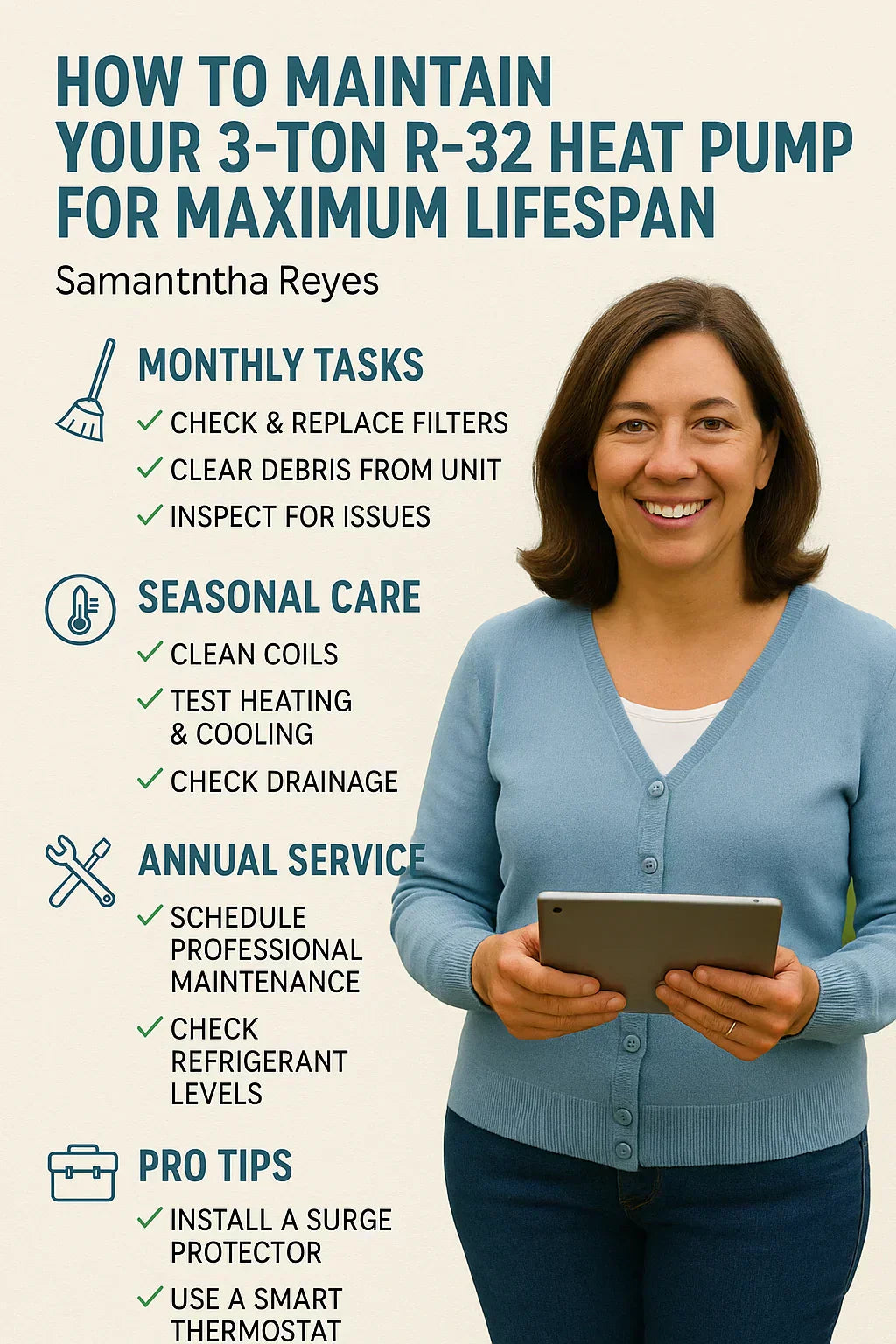💬 Introduction: Longevity Starts with Care
A few years ago, I learned the hard way that HVAC neglect can get expensive—fast. My old system, which I’d barely touched for years, needed a major coil replacement that cost almost as much as a down payment on a new car.
When I switched to a 3-ton R-32 heat pump, I promised myself I’d treat it like the investment it is. The result? My system is running at peak efficiency, and my technician says it’s in “like-new” condition after several seasons.
If you want your R-32 heat pump to last 15 years or more, you need a solid maintenance routine—and that’s exactly what this guide covers.
🧹 Monthly DIY Maintenance Tasks
You don’t have to be an HVAC pro to keep your system in good shape between service visits.
1. Check & Replace Air Filters
-
Frequency: Every 1–3 months.
-
Clogged filters restrict airflow, reducing efficiency and stressing the compressor
-
Use high-quality pleated filters sized to your system’s specs.
2. Keep Outdoor Unit Clear
-
Maintain at least 2 feet of clearance around the condenser.
-
Remove leaves, twigs, grass clippings, and snow buildup.
-
Trim plants and bushes regularly.
3. Inspect for Unusual Noises or Vibrations
-
Rattles or grinding noises could mean loose panels or worn fan bearings.
-
Address issues early to avoid costly repairs.
🔄 Seasonal Maintenance Checklist
A year-round schedule keeps your R-32 heat pump ready for whatever the weather throws at it.
Spring (Cooling Prep)
-
Wash outdoor coil with a garden hose (no pressure washers).
-
Inspect refrigerant lines for wear or damage.
-
Test cooling mode to ensure smooth switchover from heating.
Summer (High-Demand Cooling)
-
Monitor indoor humidity; a steady rise could mean coil or airflow issues.
-
Keep an eye on thermostat accuracy.
Fall (Heating Prep)
-
Test defrost cycle before temperatures drop.
-
Clear gutters to prevent drainage overflow near the outdoor unit.
-
Switch thermostat to heating mode and run a trial cycle.
Winter (Cold-Weather Care)
-
Keep snow and ice away from the outdoor unit (Energy.gov Cold Climate Heat Pump Tips).
-
Gently brush off frost buildup if defrost cycle hasn’t engaged.
-
Avoid blocking exhaust air with snow piles.
🛠️ Annual Professional Service
Even the best DIY routine can’t replace the precision of a trained HVAC tech—especially with R-32 refrigerant.
A typical annual service visit should include:
-
Coil cleaning (indoor & outdoor).
-
Refrigerant charge check using R-32-compatible gauges.
-
Electrical inspection for loose connections or corrosion.
-
Lubrication of moving parts (if applicable).
-
Performance testing in both heating and cooling modes.
Pro Tip: Make sure your tech is R-32 certified, since it’s an A2L (mildly flammable) refrigerant (AHRI A2L Safety Guidelines).
⚙️ R-32-Specific Care Tips
Your 3-ton R-32 system has some unique needs compared to older R-410A units.
-
Use Proper Leak Detection Tools
-
Standard detectors may not be calibrated for R-32’s sensitivity range.
-
-
Avoid Overcharging Refrigerant
-
Too much refrigerant reduces efficiency and can cause compressor failure (Daikin R-32 Technical Guide).
-
-
Safety First
-
Follow A2L handling guidelines during service to prevent fire risk.
-
💰 Cost of Maintenance vs. Cost of Neglect
A little prevention goes a long way.
Average Annual Maintenance Cost:
-
$150–$300 for one professional tune-up.
Common Repair Costs from Neglect:
-
Compressor replacement: $1,500–$3,000
-
Coil replacement: $800–$2,000
-
Refrigerant leak repair: $500–$1,200
Skipping maintenance for three years can easily add thousands to your lifetime system costs (Heat Pump Repair Cost Data).
🌎 Efficiency & Environmental Benefits
Regular maintenance isn’t just good for your wallet—it’s good for the planet.
-
Clean coils improve heat transfer, reducing energy use by up to 15%
-
A leak-free R-32 system keeps its low GWP advantage intact, preventing refrigerant release into the atmosphere (EPA AIM Act Overview).
🧰 Samantha’s Pro Tips for Heat Pump Longevity
-
Install a Surge Protector – Protects electronics from lightning or power surges.
-
Use a Smart Thermostat – Smooths temperature swings and reduces wear.
-
Keep a Maintenance Log – Track service dates, filter changes, and repairs.
-
Schedule Off-Season Service – Spring and fall tune-ups are often cheaper and easier to book.
💬 Closing Thoughts
If you treat your 3-ton R-32 heat pump like a “set it and forget it” appliance, it’ll give you about as much love as you give it—not much.
But if you spend a few minutes each month and a couple of hours a year on care, you can enjoy:
-
Lower energy bills
-
Fewer breakdowns
-
A system that lasts 15+ years without major overhauls
My R-32 has paid me back in comfort, savings, and peace of mind—and with the right maintenance, yours can too.
In the next topic we will read about: DIY or Hire a Pro? What Samantha Learned Installing Her 3-Ton R-32 Heat Pump







